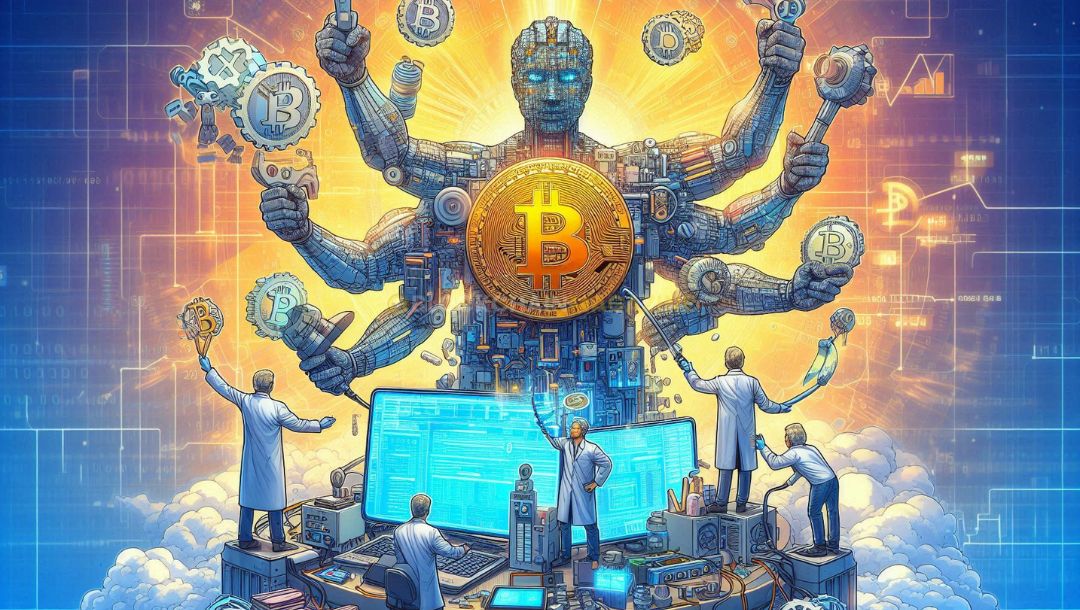What Is The Process of Verifying Bitcoin Transactions And Adding Them to The Blockchain Called?
In the world of Bitcoin, understanding how transactions are checked and added to the blockchain is essential. This process involves various steps and players, primarily miners, who work hard to keep the system secure and efficient. In this article, we will explore the different aspects of verifying Bitcoin transactions and the importance of this process in maintaining the integrity of the blockchain.
Key Takeaways
- Bitcoin transactions are verified by miners who solve complex problems.
- The blockchain is a chain of blocks that securely holds transaction data.
- Verification is crucial to prevent fraud and ensure trust in Bitcoin.
- Mining involves using powerful computers to validate transactions and add them to the blockchain.
- Future improvements in mining and regulations may enhance the verification process.
Understanding Bitcoin Transaction Verification
Bitcoin transaction verification is a crucial process that ensures the integrity and security of digital money transfers. Every transaction is recorded on the blockchain, which acts as a public ledger. This verification process involves several key steps:
- Transaction Creation: A user initiates a transaction by sending Bitcoin to another user. This transaction includes details like the sender’s and recipient’s addresses.
- Broadcasting the Transaction: Once created, the transaction is broadcasted to the Bitcoin network, where miners can see it.
- Verification by Miners: Miners check the transaction for validity, ensuring that the sender has enough Bitcoin to complete the transaction and that it hasn’t been spent before.
- Inclusion in a Block: Valid transactions are grouped together into a block, which is then added to the blockchain after being verified through a process called mining.
The Role of Miners in Verification
Miners play a vital role in the verification process. They use powerful computers to solve complex mathematical problems that validate transactions. This process not only confirms the transactions but also secures the network against fraud.
How Transactions Are Validated
Transactions are validated through a consensus mechanism known as Proof of Work. This requires miners to compete to solve a puzzle, and the first one to solve it gets to add the block of transactions to the blockchain.
Importance of Verification in Blockchain
Verification is essential for maintaining trust in the Bitcoin network. It prevents double spending and ensures that all transactions are legitimate. Without this verification process, the entire system could be compromised, leading to potential fraud and loss of funds.
The verification of Bitcoin transactions is not just a technical process; it is the backbone of trust in the cryptocurrency system. Without it, users would have no confidence in the security of their transactions.
The Concept of Blockchain in Bitcoin
Structure of a Blockchain
A blockchain is like a digital ledger that keeps track of all Bitcoin transactions. It is made up of blocks, which are groups of transactions. Each block is linked to the one before it, forming a chain. This structure helps ensure that no one can change the information without everyone knowing. Each block contains important data such as:
- Transaction details
- A unique code called a hash
- The hash of the previous block
How Blockchain Ensures Security
The security of the blockchain comes from its design. Here are some key points:
- Decentralization: No single person controls the blockchain, making it hard to hack.
- Transparency: Everyone can see the transactions, which helps prevent fraud.
- Consensus Mechanisms: These are rules that everyone agrees on to validate transactions, ensuring that all transactions are legitimate.
Decentralization and Its Benefits
Decentralization is a major feature of blockchain technology. It means that no single entity has control over the entire network. This has several benefits:
- Increased security: Harder for hackers to attack.
- Greater trust: Users can verify transactions themselves.
- Reduced costs: Fewer middlemen mean lower fees.
The blockchain is a powerful tool that promotes trust and security in digital transactions. It allows people to transact directly without needing a bank or other middleman, making it a revolutionary technology in finance.
Mining: The Heart of Bitcoin Verification
Bitcoin mining is a crucial part of how the Bitcoin network works. It is the process by which new bitcoins are introduced into circulation and transactions are verified and added to the blockchain. Miners use powerful computers to solve complex math problems, which helps confirm transactions and secure the network. Here are some key points about Bitcoin mining:
- Miners validate transactions by grouping them into blocks.
- Each block is added to the blockchain after solving a difficult puzzle, known as the proof of work.
- Miners are rewarded with new bitcoins and transaction fees for their efforts.
What Is Bitcoin Mining?
Bitcoin mining is not just about creating new bitcoins; it also ensures that all transactions are legitimate. Miners check each transaction to prevent fraud and double spending. This process keeps the Bitcoin network safe and trustworthy.
Proof of Work Explained
The proof of work is a system that requires miners to perform a significant amount of computational work to add a new block to the blockchain. This makes it hard for anyone to cheat the system. The more miners there are, the more secure the network becomes.
Mining Rewards and Incentives
Miners are motivated by rewards. They earn bitcoins for every block they successfully mine. This reward decreases over time, which is designed to control the total supply of bitcoins. Here’s a quick look at how the rewards work:
| Year | Block Reward | Total Bitcoins Mined |
|---|---|---|
| 2009 | 50 BTC | 10,500,000 BTC |
| 2012 | 25 BTC | 15,750,000 BTC |
| 2016 | 12.5 BTC | 17,250,000 BTC |
| 2020 | 6.25 BTC | 18,375,000 BTC |
Mining is essential for the Bitcoin network, as it not only creates new coins but also secures the entire system. Without miners, the network would be vulnerable to attacks and fraud.
Tools and Technologies for Verification
Software Used in Bitcoin Mining
Bitcoin mining relies on specialized software to verify transactions and add them to the blockchain. Some popular mining software includes:
- CGMiner: A widely used program that supports various hardware.
- BFGMiner: Focuses on FPGA and ASIC mining.
- EasyMiner: A user-friendly interface for beginners.
Hardware Requirements for Mining
To effectively mine Bitcoin, certain hardware is essential. Here are the main components:
- ASIC Miners: These are specialized devices designed for Bitcoin mining.
- GPUs: Graphics Processing Units can also be used, but they are less efficient than ASICs.
- Power Supply Units: A reliable power source is crucial for running mining rigs.
Energy Consumption in Mining
Mining Bitcoin consumes a significant amount of energy. Here’s a brief overview:
- High Energy Use: Mining operations require a lot of electricity.
- Environmental Impact: The energy source can affect the environment, especially if it comes from fossil fuels.
- Efficiency Improvements: New technologies aim to reduce energy consumption in mining.
The tools and technologies used in Bitcoin mining are vital for ensuring the security and integrity of transactions. Without them, the entire system would be vulnerable to fraud.
In summary, the combination of software, hardware, and energy management plays a crucial role in the verification process of Bitcoin transactions. Understanding these tools helps in grasping how the blockchain operates effectively.
Challenges in Bitcoin Transaction Verification
Scalability Issues
As more people use Bitcoin, the network can get crowded. This means that transactions can take longer to process. Scalability is a big concern because the system needs to handle many transactions at once without slowing down.
Security Concerns
Bitcoin transactions are generally secure, but there are still risks. Hackers can try to attack the network or steal funds. Here are some common security issues:
- Phishing attacks: Scammers trick users into giving away their private keys.
- Double spending: This happens when someone tries to spend the same Bitcoin twice.
- Network attacks: Hackers can try to disrupt the network to cause delays.
Environmental Impact
Mining Bitcoin requires a lot of energy, which can harm the environment. The energy used for mining can lead to higher carbon emissions. Here are some points to consider:
- High energy consumption: Mining operations use large amounts of electricity.
- Carbon footprint: The energy sources used can contribute to pollution.
- Sustainable alternatives: Some are looking for greener ways to mine Bitcoin.
The challenges in cryptocurrency transaction monitoring are significant due to the lack of regulation, anonymity, and pseudonymity of transactions.
These challenges show that while Bitcoin is a great innovation, it also has problems that need to be solved for it to grow and be used safely.
Future of Bitcoin Transaction Verification
Innovations in Blockchain Technology
The future of Bitcoin transaction verification looks promising with new advancements in blockchain technology. These innovations aim to make transactions faster and more secure. Some key areas of focus include:
- Layer 2 Solutions: These are technologies built on top of the main blockchain to help process transactions more quickly.
- Smart Contracts: These are self-executing contracts with the terms directly written into code, which can automate and secure transactions.
- Interoperability: This allows different blockchains to work together, enhancing the overall efficiency of the system.
Potential Improvements in Mining Efficiency
Mining is crucial for verifying transactions, and improvements in this area can lead to better performance. Some potential improvements include:
- Energy-efficient Hardware: New mining machines that use less power while providing more processing power.
- Renewable Energy Sources: Using solar or wind energy to power mining operations, reducing environmental impact.
- Optimized Algorithms: Developing better algorithms that require less computational power to verify transactions.
The Role of Regulation in Bitcoin Verification
Regulation can play a significant role in shaping the future of Bitcoin verification. Some important points to consider are:
- Consumer Protection: Regulations can help protect users from fraud and scams.
- Standardization: Creating common standards can improve the reliability of transactions.
- Tax Compliance: Clear rules can help users understand their tax obligations related to Bitcoin transactions.
The future of Bitcoin verification is not just about technology; it also involves trust and security in the digital world. As we move forward, finding the right balance between innovation and regulation will be key to success.
Conclusion
In summary, the process of checking Bitcoin transactions and adding them to the blockchain is called mining. This important job helps keep the Bitcoin network safe and running smoothly. Miners use powerful computers to solve tough math problems, which helps confirm that transactions are real and not fake. Once a miner solves a problem, they add a new block of transactions to the blockchain, making it harder for anyone to cheat the system. Overall, mining is a key part of how Bitcoin works, ensuring that everyone can trust the digital currency.
Frequently Asked Questions
What does it mean to verify a Bitcoin transaction?
Verifying a Bitcoin transaction means checking that the transaction is real and that the sender has enough Bitcoin to send. This is done to make sure no one is cheating the system.
Who are the miners in Bitcoin?
Miners are people or groups who use powerful computers to solve complex math problems. They help confirm Bitcoin transactions and add them to the blockchain.
Why is the verification process important?
The verification process is important because it keeps the Bitcoin network safe. It prevents fraud and ensures that everyone follows the rules.
What is a blockchain?
A blockchain is like a digital notebook that keeps a record of all Bitcoin transactions. It is secure and can’t be easily changed, which helps keep everyone honest.
What do miners get for their work?
Miners earn rewards for their work, which can be new Bitcoins and transaction fees. This encourages them to keep verifying transactions.
What are some challenges in verifying Bitcoin transactions?
Some challenges include making sure the system can handle many transactions at once, keeping it secure from attacks, and reducing the environmental impact of mining.
Stay informed with daily updates from Blockchain Magazine on Google News. Click here to follow us and mark as favorite: [Blockchain Magazine on Google News].
Get Blockchain Insights In Inbox
Stay ahead of the curve with expert analysis and market updates.
latest from tech
Disclaimer: Any post shared by a third-party agency are sponsored and Blockchain Magazine has no views on any such posts. The views and opinions expressed in this post are those of the clients and do not necessarily reflect the official policy or position of Blockchain Magazine. The information provided in this post is for informational purposes only and should not be considered as financial, investment, or professional advice. Blockchain Magazine does not endorse or promote any specific products, services, or companies mentioned in this posts. Readers are encouraged to conduct their own research and consult with a qualified professional before making any financial decisions. The featured image used is just a creative depiction of the title and it does not intend to hurt sentiments of any person or institution. If it hurts anyone sentiments, please do not hesitate to reach out to Blockchain Magazine.

 Bitcoin
Bitcoin  Ethereum
Ethereum  XRP
XRP  Tether
Tether  Solana
Solana  Dogecoin
Dogecoin  USDC
USDC  Cardano
Cardano  Lido Staked Ether
Lido Staked Ether  TRON
TRON  Chainlink
Chainlink  Avalanche
Avalanche  Stellar
Stellar  Wrapped stETH
Wrapped stETH  Wrapped Bitcoin
Wrapped Bitcoin  Hedera
Hedera  Sui
Sui  Toncoin
Toncoin  Shiba Inu
Shiba Inu  WETH
WETH  Polkadot
Polkadot  Parkcoin
Parkcoin  LEO Token
LEO Token  Litecoin
Litecoin  Bitget Token
Bitget Token  Bitcoin Cash
Bitcoin Cash  Uniswap
Uniswap  Hyperliquid
Hyperliquid  Official Trump
Official Trump  Wrapped eETH
Wrapped eETH  Pepe
Pepe  USDS
USDS  NEAR Protocol
NEAR Protocol  Ethena USDe
Ethena USDe  Aave
Aave  Aptos
Aptos  Internet Computer
Internet Computer  Ondo
Ondo  Ethereum Classic
Ethereum Classic  Monero
Monero  POL (ex-MATIC)
POL (ex-MATIC)  Algorand
Algorand  Cronos
Cronos  Dai
Dai  OKB
OKB  Mantle
Mantle  MANTRA
MANTRA  Render
Render 




